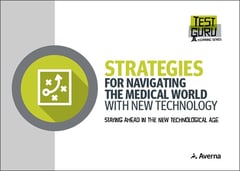
Key Takeaways: What You will Learn About IQ/OQ/PQ
- ► IQ, OQ, and PQ are essential validation phases in medical device manufacturing that ensure equipment is installed correctly.
- ► Each phase has a distinct focus: IQ covers installation and setup, OQ tests operational and PQ validates performance in real-world conditions.
- ► Regulatory compliance relies on proper documentation of IQ/OQ/PQ protocols, as required by bodies like the FDA and EMA.
- ► Automated equipment and robotics simplify validation, improve precision, and help meet increasing regulatory demands.
- ► Partnering with experts like Averna can streamline the validation process, reduce re-validation time, and ensure compliance through modular systems and standardization.
IQ, OQ, and PQ are three critical phases of equipment validation that ensure safety, reliability, and regulatory compliance in the world of medical device manufacturing. From the moment a piece of equipment enters a facility to the time it’s used in production, it must meet rigorous standards.
A product is only as good as the factory it is built in. This proves to be especially true in terms of medical devices. From a business perspective, meeting compliance regulations is one of the greatest challenges medical manufacturers struggle with. This is not to say it is always difficult to do (though it can be with such complicated products), but it is a long, time-consuming, and expensive process.
IQ/OQ/PQ Meaning
To elaborate on IQ/OQ/PQ, there’s IQ – Installation Qualification, OQ – Operational Qualification, and PQ – Performance Qualification. They may not always be called these exact terms but these validation steps are essential in regulated industries, where equipment must consistently perform without exception. Why so many acronyms, you ask? Because they all affect the quality and the output of the factory.
Difference Between IQ, OQ, and PQ in the Validation Lifecycle
Understanding the distinctions between IQ, OQ, and PQ helps clarify their role in the validation lifecycle:
|
Qualification |
Focus |
Environment |
Example |
|
IQ |
Installation |
Setup phase |
Floor space, utilities, calibration |
|
OQ |
Functionality |
Controlled testing |
Alarm challenges, load variations |
|
PQ |
Performance |
Real-world production |
Batch uniformity, repeatability |
Installation Qualification (IQ)
IQ ensures that equipment is installed according to vendor specifications. This step confirms that the equipment is ready for operation and meets all physical and environmental requirements. It’s the foundation of validation and considers measurable criteria like floor space verification, connected utilities, calibration certificates and environmental conditions.
Typically, the required documentation would include:
- Installation checklists
- Software and driver revision checks
- Calibration records
- Supplier manuals
- Traceability baseline
Operational Qualification (OQ)
OQ demonstrates that equipment functions within defined specifications and under stress. It’s about testing the limits and ensuring reliability. Techniques like FMEA (Failure Mode and Effects Analysis) or fault-tree analysis help prioritize what to test. It is crucial for compliance to document the entire process.

Test cases can include:
- Fault insertions
- Alarm challenges
- Recovery time
- Temperature changes
- Load variations
- Interoperability with other equipment
Performance Qualification (PQ)
PQ confirms the system performs consistently in simulated production. It’s the final validation step before full-scale manufacturing. PQ connects to Process Performance Qualification, which monitors long-term stability under actual manufacturing conditions.
Objective measures include:
- Batch uniformity
- Repeatability of results (Gage R&R)
- Process capability (Cp/Cpk)
IQ, OQ, and PQ Validation Protocols in Medical Devices
Regulatory bodies such as the FDA and EMA require documented protocols and reports for every stage of equipment validation which is why IQ/OQ/PQ protocols are not optional. It’s important to understand that these protocols are a direct path to compliance. They ensure that equipment is safe, accurate, and approved for production.
IQ/OQ/PQ Testing Examples
There are many IQ/OQ/PQ application examples across medical testing equipment:
- IQ: Verifying that a sterilizer is installed with proper drainage and electrical connections.
- OQ: Testing a centrifuge’s speed consistency under varying loads.
- PQ: Running a full production batch to confirm consistent output and quality.
These examples show how validation applies to the real world to ensure that equipment performs reliably and safely.
Why IQ/OQ/PQ Matters for Medical Testing Equipment
IQ/OQ/PQ ensures that test equipment is installed correctly, functions reliably under varying conditions and performs consistently in production.
This validation protects patients, companies, supports regulatory compliance, and reduces costly downtime.
Risk-Based Validation and Data Integrity Expectations
Modern validation emphasizes risk-based approaches and data integrity. By focusing on critical functions and using tools like CSA (Computer Software Assurance), manufacturers can streamline validation while maintaining compliance.
Averna has a dedicated validation process built on top of GAMP 5 V-model; a specific engineering process for test & validation equipment. Here is an example of a starting point for reliable validation:

Automating the Test Process to Simplify IQ/OQ/PQ
Automated test solutions and robotics are revolutionizing production by improving precision and repeatability and automating data collection. For example, Averna’s vision and optical inspection systems enhance quality control for product quality, like medical packaging inspection. These systems manage both the FDA’s increased scrutiny of manual inspections while also automating documentation to simplify compliance.
Optimizing your validation process
Any time you change an item that has been validated you must run your validation process again. Planning ahead for change with modular system architecture, documentation, and validation processes ensures minimal re-validation time without increasing risk to patients.
 Keeping IQ/OQ/PQ Simple with the Right Partner
Keeping IQ/OQ/PQ Simple with the Right Partner
A trusted partner, like Averna, helps define validation strategies, execute protocols, and maintain documentation. Protocols can feel complex, but with modular and standardized equipment and a knowledgeable partner, the process is smoother.
For more information on IQ/OQ/PQ support and medical device testing, please contact Averna.
--
You may also be interested in…
Looking for other ways to navigate the medical manufacturing world? Read our eBook to plan for advanced automation, IoT and connectivity strategies.
Get in touch with our experts or navigate through our resource center.
